
The national pastime for toddlers is undeniably naptime. However, as we attempt to mature as high school students, we are slowly but surely deprived of our precious Z’s.
Implementing naptime may be the solution to Palo Alto High School’s notorious stress problem. Many students complain that they don’t get enough sleep, and for these individuals, this will be the perfect opportunity to replenish their reserves.
Paly expects its students to excel academically, but how can that be possible without the energy to do so?
According to Mayo Clinic, napping provides both long- and short-term benefits, including quicker reaction time, better memory, fewer mistakes, increased alertness and improved mood. These beneficial and practical effects would go a long way in aiding students mentally.
Sleep is obviously necessary in improving our lives and well-being, and other nations have already acted on this idea. Many countries have integrated naptime into their cultures, with the most well-known example probably being the siesta in Spain and much of Latin America. If naptime has been accepted as an age-old tradition there, why shouldn’t we follow suit?
Even in a fast-paced environment much closer to home, Google employees embrace the importance of naps and find the time to get some shut-eye throughout the day, installing “EnergyPods” in their office buildings. These EnergyPods have all the necessary features to ensure quality naptime experiences. Set in a reclining position, they block out external stimuli and lull users to sleep with soft music. A timer system wakes occupants up with vibrations and lights after a set time.
Naptime is clearly effective enough to have caught the attention of this international tech conglomeration, and while Paly does not have to be quite as high-tech as Google, we can still follow their lead. After all, if fully-employed adults can take a midday snooze, then we should be able to do the same.
Naps can be short but still very effective. In fact, just 10 to 30 minute-long naps, or “power” naps, can majorly increase learning and performance abilities, according to studies like Harry S. Truman VA Hospital’s research article “Good sleep, bad sleep! The role of daytime naps in healthy adults.” With all of these more-than-worthwhile benefits packed into just a few minutes, what makes it so hard to create a nap period? The answer: nothing.
As the year drags on, the number of students cautiously resting their heads on the their desks gradually increases. A nap period would provide teachers and students a well-deserved respite.
Naptime used to be an integral part of our childhood and contributed to a blissfully fun, low-stress life. Many of us, whether we admit it or not, wistfully look back at those days of childhood naivety and innocence. In a world filled with stress, the return to a naptime would definitely be a step in the right direction.

